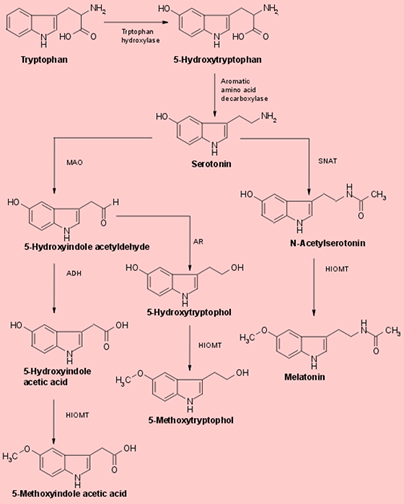Clock Molecules

It is now well established that a central oscillator located in the suprachiasmatic nucleus (SCN) of the hypothalamus in brain, in co-ordination with several peripheral clocks regulates the circadian rhythms in mammals. Five clock-gene families have so far been found to be involved.
Melatonin is an internal factor secreted in response to the circadian clock. Light sensed by melanopsin in the retina of the eye is converted to signals that are sent to the SCN close to where the clock genes are located. Stimulation from the SCN controls production of melatonin by the pineal gland.

Melatonin is synthesized from tryptophan, an essential amino acid in humans.
Tryptophan is converted to serotonin, which is then converted to N-acetyl serotonin
by N-acetyl transferase enzyme (NAT) and then to melatonin or 5-methoxy-N-acetyltryptamine
by hydroxyindole-O-methyl transferase (HIOMT). Both NAT and HIOMT are rate limiting
enzymes in melatonin production. The enzymes are synthesized in response to
the circadian rhythm. Once made, melatonin is secreted into blood and cerebrospinal
fluid. Melatonin secretion is rhythmic. Daytime levels are low, and night-time
levels are high, with peak levels between 0200 and 0600 hrs. Melatonin is also
found in peripheral organs such as the gut. Melatonin has been shown to shift
biological rhythms and sleep cycles, and is now increasingly used to treat or
prevent jet lags and other sleep related problems.